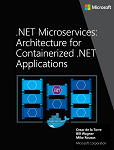ヒント
このコンテンツは eBook の「コンテナー化された .NET アプリケーションの .NET マイクロサービス アーキテクチャ」からの抜粋です。.NET Docs で閲覧できるほか、PDF として無料ダウンロードすると、オンラインで閲覧できます。

Azure SQL DB の場合、Entity Framework (EF) Core に内部データベース接続の復元機能と再試行ロジックが既に用意されています。 ただし、回復力のある EF Core 接続を使用する場合は、各 DbContext 接続に対して Entity Framework 実行戦略を有効にする必要があります。
たとえば、EF Core 接続レベルで次のコードを実行すると、接続が失敗した場合に再試行される回復力のある SQL 接続が有効になります。
// Program.cs from any ASP.NET Core Web API
// Other code ...
builder.Services.AddDbContext<CatalogContext>(options =>
{
options.UseSqlServer(
builder.Configuration["ConnectionString"],
sqlServerOptionsAction: sqlOptions =>
{
sqlOptions.EnableRetryOnFailure(
maxRetryCount: 10,
maxRetryDelay: TimeSpan.FromSeconds(30),
errorNumbersToAdd: null);
});
});
重要
Microsoft では、使用可能な最も安全な認証フローを使用することをお勧めします。 Azure SQL に接続する場合は、Azure リソースの管理 ID が推奨される認証方法です。
BeginTransaction と複数の DbContext を使用した実行戦略と明示的なトランザクション
EF Core 接続で再試行を有効にすると、EF Core を使用して実行する各操作は、独自の再試行可能な操作になります。 一時的なエラーが発生した場合、SaveChanges への各クエリと各呼び出しは 1 つのユニットとして再試行されます。
一方、BeginTransaction を使用してトランザクションを開始するコードの場合、1 ユニットとして扱う必要のある独自の操作グループを定義しています。 エラーが発生した場合は、トランザクション内のすべてをロールバックする必要があります。
EF 実行戦略 (再試行ポリシー) を使用しているときにそのトランザクションを実行しようとして、複数の DbContext から SaveChanges を呼び出すと、次のような例外を受け取ります。
System.InvalidOperationException:構成された実行戦略 'SqlServerRetryingExecutionStrategy' は、ユーザーが開始したトランザクションをサポートしていません。 'DbContext.Database.CreateExecutionStrategy()' から返された実行戦略を使用して、再試行可能なユニットとしてトランザクション内のすべての操作を実行します。
この解決策では、実行する必要があるすべてを表すデリゲートを使用して EF 実行戦略を手動で呼び出します。 一時的なエラーが発生した場合、実行戦略によってデリゲートが再び呼び出されます。 たとえば、次のコードは、製品を更新し、別の DbContext を使用する必要がある ProductPriceChangedIntegrationEvent オブジェクトを保存するときに、2 つの DbContext (_catalogContext と IntegrationEventLogContext) を使用して eShopOnContainers で実装する方法を示しています。
public async Task<IActionResult> UpdateProduct(
[FromBody]CatalogItem productToUpdate)
{
// Other code ...
var oldPrice = catalogItem.Price;
var raiseProductPriceChangedEvent = oldPrice != productToUpdate.Price;
// Update current product
catalogItem = productToUpdate;
// Save product's data and publish integration event through the Event Bus
// if price has changed
if (raiseProductPriceChangedEvent)
{
//Create Integration Event to be published through the Event Bus
var priceChangedEvent = new ProductPriceChangedIntegrationEvent(
catalogItem.Id, productToUpdate.Price, oldPrice);
// Achieving atomicity between original Catalog database operation and the
// IntegrationEventLog thanks to a local transaction
await _catalogIntegrationEventService.SaveEventAndCatalogContextChangesAsync(
priceChangedEvent);
// Publish through the Event Bus and mark the saved event as published
await _catalogIntegrationEventService.PublishThroughEventBusAsync(
priceChangedEvent);
}
// Just save the updated product because the Product's Price hasn't changed.
else
{
await _catalogContext.SaveChangesAsync();
}
}
最初の DbContext は _catalogContext であり、2 つ目の DbContext は _catalogIntegrationEventService オブジェクト内にあります。 Commit アクションは、EF 実行戦略を使用してすべての DbContext オブジェクト全体で実行されます。
この複数の DbContext コミットを達成するために、次のコード例に示すように、SaveEventAndCatalogContextChangesAsync には ResilientTransaction クラスが使用されます。
public class CatalogIntegrationEventService : ICatalogIntegrationEventService
{
//…
public async Task SaveEventAndCatalogContextChangesAsync(
IntegrationEvent evt)
{
// Use of an EF Core resiliency strategy when using multiple DbContexts
// within an explicit BeginTransaction():
// https://learn.microsoft.com/ef/core/miscellaneous/connection-resiliency
await ResilientTransaction.New(_catalogContext).ExecuteAsync(async () =>
{
// Achieving atomicity between original catalog database
// operation and the IntegrationEventLog thanks to a local transaction
await _catalogContext.SaveChangesAsync();
await _eventLogService.SaveEventAsync(evt,
_catalogContext.Database.CurrentTransaction.GetDbTransaction());
});
}
}
基本的に、ResilientTransaction.ExecuteAsync メソッドでは、渡された DbContext (_catalogContext) からのトランザクションを開始し、次に EventLogService にそのトランザクションを使用して IntegrationEventLogContext からの変更を保存してから、トランザクション全体をコミットします。
public class ResilientTransaction
{
private DbContext _context;
private ResilientTransaction(DbContext context) =>
_context = context ?? throw new ArgumentNullException(nameof(context));
public static ResilientTransaction New (DbContext context) =>
new ResilientTransaction(context);
public async Task ExecuteAsync(Func<Task> action)
{
// Use of an EF Core resiliency strategy when using multiple DbContexts
// within an explicit BeginTransaction():
// https://learn.microsoft.com/ef/core/miscellaneous/connection-resiliency
var strategy = _context.Database.CreateExecutionStrategy();
await strategy.ExecuteAsync(async () =>
{
await using var transaction = await _context.Database.BeginTransactionAsync();
await action();
await transaction.CommitAsync();
});
}
}
その他のリソース
ASP.NET MVC アプリケーションの EF での接続回復性とコマンド傍受
https://learn.microsoft.com/aspnet/mvc/overview/getting-started/getting-started-with-ef-using-mvc/connection-resiliency-and-command-interception-with-the-entity-framework-in-an-asp-net-mvc-applicationCesar de la Torre。 回復力の高い Entity Framework Core SQL 接続とトランザクションの使用
https://devblogs.microsoft.com/cesardelatorre/using-resilient-entity-framework-core-sql-connections-and-transactions-retries-with-exponential-backoff/
.NET
